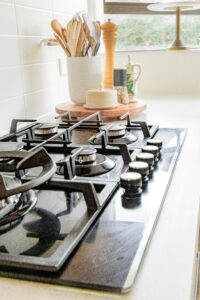Soap residue buildup is a common problem in many homes, yet it is often overlooked or underestimated. Soap residue buildup occurs when soap is not properly rinsed off surfaces and appliances, leading to a sticky film that can be difficult to remove. This buildup not only affects the appearance of your home, but it can also have negative effects on your health. Understanding and preventing soap residue buildup is essential for maintaining a clean and healthy living environment.
Key Takeaways
- Soap residue buildup can happen when soap is not rinsed off properly and accumulates over time.
- Soap residue buildup can cause damage to surfaces, create unpleasant odors, and even lead to health issues.
- Signs of soap residue buildup include a filmy or sticky feeling, discoloration, and a buildup of grime and dirt.
- Soap residue buildup occurs due to the chemical properties of soap, which can react with hard water minerals and create a buildup.
- Common areas where soap residue accumulates include shower walls, sinks, and kitchen countertops.
What is Soap Residue Buildup and How Does it Happen?
Soap residue buildup refers to the accumulation of soap particles on surfaces and appliances in your home. When soap is used for cleaning, it leaves behind a thin layer of residue that can build up over time if not properly rinsed off. This buildup can occur on a variety of surfaces, including shower tiles, sinks, countertops, and appliances.
One factor that contributes to soap residue buildup is the use of hard water. Hard water contains high levels of minerals such as calcium and magnesium, which can react with soap to form insoluble compounds. These compounds can then cling to surfaces and create a sticky film that is difficult to remove.
The Effects of Soap Residue Buildup on Your Home and Health
Soap residue buildup can have several negative effects on both your home and your health. In terms of your home, soap residue can make surfaces appear dull and dirty. It can also cause discoloration and damage to certain materials, such as stainless steel appliances or glass shower doors.
In addition to the aesthetic effects, soap residue buildup can also have health implications. When soap residue is left on surfaces that come into contact with food or water, it can contaminate these items. This can lead to gastrointestinal issues if ingested or skin irritation if it comes into contact with the skin.
Identifying Soap Residue Buildup: Signs and Symptoms
There are several signs and symptoms that can indicate the presence of soap residue buildup in your home. One common sign is a sticky or greasy feeling on surfaces, such as countertops or shower tiles. You may also notice a dull or hazy appearance on glass surfaces, such as mirrors or shower doors.
Another symptom of soap residue buildup is difficulty in cleaning surfaces. If you find that no matter how much you scrub, the soap residue does not come off, it is likely that there is a buildup present. Additionally, if you notice a foul odor coming from your sink or drain, this could be a sign of soap residue buildup.
It is important to note that soap residue buildup can sometimes be mistaken for other types of buildup, such as hard water stains or mold. However, there are some key differences to look out for. Soap residue buildup is typically sticky and greasy in texture, whereas hard water stains are more chalky or crusty. Mold, on the other hand, usually has a fuzzy or slimy appearance.
Understanding the Chemistry of Soap and Why it Causes Buildup
To understand why soap residue buildup occurs, it is helpful to have a basic understanding of the chemistry of soap. Soap is made up of molecules that have a hydrophilic (water-loving) head and a hydrophobic (water-repelling) tail. When soap is mixed with water, the hydrophilic heads are attracted to the water molecules, while the hydrophobic tails repel them.
When soap is used for cleaning, it works by attaching to dirt and oil particles on surfaces. The hydrophobic tails of the soap molecules surround these particles, while the hydrophilic heads remain in contact with the water. This allows the dirt and oil to be lifted off the surface and rinsed away.
However, if soap is not properly rinsed off after cleaning, some of the soap molecules can remain on the surface. Over time, these molecules can accumulate and form a sticky film, resulting in soap residue buildup.
Common Areas Where Soap Residue Accumulates in the Home

Soap residue buildup can occur in various areas of your home. One common area is the bathroom, particularly in the shower or bathtub. Soap residue can accumulate on shower tiles, glass doors, and fixtures, making them appear dull and dirty.
Another area where soap residue buildup is common is the kitchen. Soap residue can accumulate on countertops, sinks, and appliances such as dishwashers or coffee makers. This can make these surfaces sticky and difficult to clean.
Additionally, soap residue buildup can occur in laundry rooms, particularly on washing machines or laundry sinks. This can affect the performance of your washing machine and leave a residue on your clothes.
The Importance of Regular Cleaning to Prevent Soap Residue Buildup
Regular cleaning is essential for preventing soap residue buildup in your home. By regularly cleaning surfaces and appliances, you can remove any soap residue before it has a chance to accumulate.
One important tip for effective cleaning is to use warm water when rinsing off soap. Warm water helps to dissolve and remove soap more effectively than cold water. It is also important to thoroughly rinse surfaces and appliances after cleaning to ensure that all soap residue is removed.
In addition to regular cleaning, there are some preventative measures you can take to minimize soap residue buildup. For example, using less soap when cleaning can help reduce the amount of residue left behind. You can also try using liquid soap instead of bar soap, as liquid soap tends to leave less residue.
How to Clear Soap Residue Buildup from Different Surfaces
If you already have soap residue buildup in your home, there are specific instructions you can follow to clear it from different surfaces. For shower tiles, a mixture of equal parts white vinegar and water can be effective in breaking down the soap residue. Simply spray the mixture onto the tiles, let it sit for a few minutes, and then scrub with a brush or sponge.
For sinks and countertops, a mixture of baking soda and water can be used to create a paste that can be applied to the affected areas. Let the paste sit for a few minutes, then scrub with a sponge or cloth. Rinse thoroughly with warm water to remove any residue.
When it comes to appliances, such as dishwashers or washing machines, it is important to follow the manufacturer’s instructions for cleaning. Many appliances have specific cleaning cycles or recommended cleaning products that can help remove soap residue buildup.
Natural and Chemical Solutions for Clearing Soap Residue Buildup
There are several natural and chemical solutions that can be used to clear soap residue buildup in your home. One natural solution is white vinegar, which is effective in breaking down soap residue due to its acidic properties. Simply mix equal parts white vinegar and water, and use this mixture to clean surfaces or appliances.
Another natural solution is baking soda, which can be used as a gentle abrasive to scrub away soap residue. Mix baking soda with water to create a paste, and use this paste to clean surfaces or appliances.
If you prefer to use chemical solutions, there are many commercial cleaning products available that are specifically designed to remove soap residue buildup. These products often contain enzymes or surfactants that break down the soap molecules and make them easier to remove.
It is important to note that when using any cleaning product, whether natural or chemical, it is essential to follow the instructions on the label and take proper safety precautions. This includes wearing gloves and ensuring proper ventilation when using chemical cleaners.
Tips for Maintaining a Soap Residue-Free Home
To maintain a soap residue-free home, there are several tips you can follow. First and foremost, regular cleaning is key. Make sure to clean surfaces and appliances on a regular basis to prevent soap residue from accumulating.
In addition to regular cleaning, there are some preventative measures you can take to minimize soap residue buildup. For example, using less soap when cleaning can help reduce the amount of residue left behind. You can also try using liquid soap instead of bar soap, as liquid soap tends to leave less residue.
Another tip is to rinse surfaces and appliances thoroughly after cleaning to ensure that all soap residue is removed. This can be done by using warm water and taking the time to thoroughly rinse off any soap.
Professional Cleaning Services for Heavy Soap Residue Buildup
In some cases, heavy soap residue buildup may require the assistance of professional cleaning services. Professional cleaners have the knowledge and expertise to effectively remove stubborn soap residue from surfaces and appliances.
Professional cleaning services often use specialized equipment and cleaning products that are not readily available to consumers. They also have the experience to tackle even the toughest soap residue buildup.
Hiring professional cleaning services can save you time and effort, as they will take care of the cleaning for you. They can also provide recommendations for preventing future soap residue buildup and maintaining a clean and healthy home.
Soap residue buildup is a common problem in many homes, but it is often overlooked or underestimated. Understanding and preventing soap residue buildup is essential for maintaining a clean and healthy living environment.
Soap residue buildup can have negative effects on both your home and your health. It can make surfaces appear dull and dirty, and it can also contaminate food or water, leading to potential health risks.
By regularly cleaning surfaces and appliances, using warm water for rinsing, and following proper cleaning techniques, you can prevent soap residue buildup in your home. If you already have soap residue buildup, there are natural and chemical solutions available to help clear it.
Remember, maintaining a clean and soap residue-free home requires regular cleaning and preventative measures. By taking action to prevent and clear soap residue buildup, you can ensure a clean and healthy living environment for you and your family.
If you’re dealing with soap residue buildup in your home, you’ll want to check out this informative article from 911 Appliance. They provide valuable insights on identifying and clearing soap residue accumulation, helping you maintain a clean and efficient living space. To learn more, visit their blog at https://911Appliance.com/our-blog/.
How Can I Prevent Soap Residue Buildup in the First Place?
To prevent identifying soap residue buildup, use less soap when showering or washing dishes. Rinse surfaces thoroughly, and wipe them dry to remove any excess soap. Consider using soap-free cleaning products or installing a water softener to prevent soap scum from forming in the first place.


